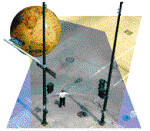Kim'chin do
Michael5000, one of my favorite bloggers, recently engaged in a creative project called Geography of the Forgotten Lands. I already knew he was interested in flag design, but it turns out he also likes to create imaginary countries! Michael has created descriptions, and flags of countries that are "part parody of reference-book prose, part commentary on world events, part pure geographical fantasy." I just think they are good fun.
The one piece missing from these delightful geographical fantasies are maps. So, from time to time I plan to draw map of these imaginary countries. Unfortunately, I am not very artistic, so if one of you artistically inclined cartophiles out there would like to draw a map with more detail (mountains, rivers, more cities, etc.) send them to me and I will be pleased to post them.
Kim’chin do
Capital: Namju
Population: 161,000 (2001 estimate)
Economy: Fishing, forestry, zinc, electronic goods.
If you look at the area northeast of Hokkaido on any world map, chances are you will see only open ocean. It is not entirely clear how an island as large as Kim'chindo came to be forgotten by the world's cartographers. As the site of major Soviet naval and air bases, it was regularly omitted from that country's maps for security purposes. While it is difficult to imagine the Western publishing companies taking their cue from the USSR, no other explanation has ever been put forward for the island nation's widespread omission from our maps and atlases.

The natives of Kim'chindo had tales of their ancestors arriving from the south on a city of rafts. Modern archaeologists have established only that a large migration arrived from the Korean penninsula, in the 12th Century A.D. A great capital of wood buildings was built on the southern tip of the island on a sophisticated plan of broad boulevards and great open plazas. This city, Kim'sol, was destroyed by a tidal wave in around 1620:

My cityAs much as half the island's population perished in the disaster.
floats out to sea
in jumbled sticks.
-- Ko Tae-Li, 17th Century
In the modern era, the island was handed from empire to empire: the British (1710) were followed by the Dutch (1770), the Japanese (1906), and the Soviets (1945). Kim'chindo stumbled into independence after the breakup of the USSR with a small but polyglot population (34% Japanese, 32% Kim'chin Korean, 12% Russian, 12% Chinese, 10% European) and no tradition of self-government. A parliamentary system has been established and elections held, but the real power in Kim'chindo is held by the large corporations (mostly Japanese and Dutch) that have acquired its mills, mines, and factories. Nearly 40% of working citizens, a 2002 study found, are in the employ of a foreign corporation. Wages and investment in national infrastructure remain well below world averages.
 Flag: The Kim'chin, like many Asian cultures, associated colors with direction. The modern flag, designed in 1993, is thus a sort of traditional map. Red, in the center, represents the people. Black is to the north, white to the south, yellow is to the west, and green to the east. Blue and purple were considered the colors of danger in classical Kim'chinsymbology, and are rarely seen in traditional decoration.
Flag: The Kim'chin, like many Asian cultures, associated colors with direction. The modern flag, designed in 1993, is thus a sort of traditional map. Red, in the center, represents the people. Black is to the north, white to the south, yellow is to the west, and green to the east. Blue and purple were considered the colors of danger in classical Kim'chinsymbology, and are rarely seen in traditional decoration.Kim'chin do description and flag by Michael5000.
Labels: flags, forgotten lands, imaginary countries





4 Comments:
w00t!
Could someone please explane to me, why I can't find this island on Google Earth?
Defective.
The three-dimensional quality of the flag is unique.
Post a Comment
Subscribe to Post Comments [Atom]
<< Home